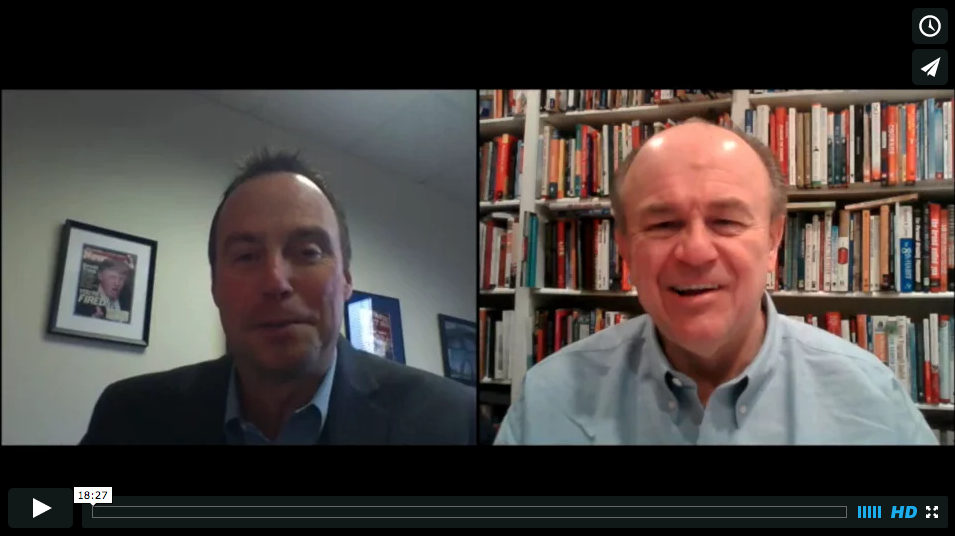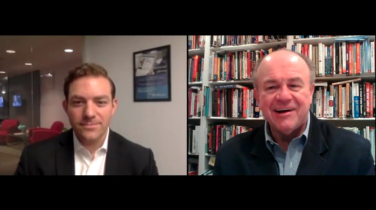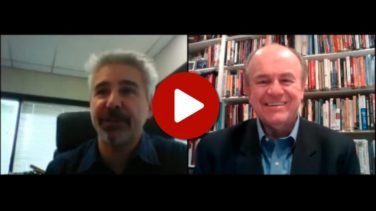PM360 Chris Dowd from PM360 Online on Vimeo.
Pharma companies have seen the benefits of co-pay programs for their products, but Chris Dowd, Executive Vice President, Market and Product Development, PSKW, believes there is still untapped potential in these programs. Not only does he reveal what co-pay offers can do if pharma companies’ operations were a little less siloed, but he also examines the new channels where you can make co-pay offers, how to actually decide what is the right offer and the latest controversy regarding co-pay assistance. Contact Chris at cdowd@pskw.com to learn more.
Transcript
Bud Bilanich: Hi, everybody. Bud Bilanich back with another session of Experts on Call. And boy, do we have an expert for you today. His name is Chris Dowd and he’s the EVP of Market and Product development for a company called PSKW. So, welcome, Chris. Thanks for joining us today.
Chris Dowd: Hi, Bud. How you doing? Good to see you again and thanks for having me on this.
Bud Bilanich: It’s a pleasure, it’s always a pleasure. You know, I was just on your website before we got started here and I love your mission statement, the idea that we create more informed, more loyal and more valuable patients. Now I know if you’re a brand manager you want that. You want informed, loyal and you want valuable patients.
Chris Dowd: Right.
Bud Bilanich: So tell me a little bit about how you go about doing that over there?
Chris Dowd: That’s right. It’s good if you can get it, especially if you can get all three of those.
Bud Bilanich: You’re absolutely right.
Chris Dowd: But the idea is really that through the copay assistance experience, you can really get all three, meaning that the patient is first of all more informed about their healthcare because they’re—you know, they’re a big part of the financial decision to either fill the script or not fill the script. At the end of the day, they have to make that decision. And the cards and the copay programs and offers really let them make that final decision which is really important, and then the loyalty kicks in because often like most loyalty types of programs that interact with consumers, in this case it’s really interacting with patients, to keep them on the brand, loyal to the brand and we found that there is a connectivity there. That somebody, they feel, is kicking in, paying, helping them to fill the prescription, and there’s an instant bond, there’s an instant loyalty. So there’s always been this play on the loyalty factor that leads to adherence, compliance and all the other words that we use in the industry.
So that brought us to that theme, yeah, so when you think about the brand manager, and the pharmaceutical company, why is the patient—how could the patient be more valuable? The idea is that it’s sometimes painful and a lot of effort goes into getting—obtaining that patient. Between the cost of the samples and the sales force and the marketing, you finally have the patient and perhaps they’re at the pharmacy counter and now that final action has to take place. The copay assistance card or the copay assistance offer can be the thing that gets them over the line and into the point where they become a valuable patient, because they’ll stay on therapy, they’ll actually fill the product, come back for the product and all that. So that’s the theme with the more valuable patient.
Bud Bilanich: Yeah. So I mean just from personal experience, what I’m finding is that companies will really develop really tremendous new products and you then have the payers, you know, the insurance companies, that sort of balk at some of this. They want to make sure that the physician has tried all the other potential other therapies, especially the lower cost ones.
Chris Dowd: Right.
Bud Bilanich: So it strikes me that one of the problems that, you know, you face as a brand manager, one of the reasons you might get involved with a copay program is it makes it easier for the patient to fill that original script and get some reimbursement for it. So I think that that—the—just where we are with healthcare and payers and everything these days, this seems like it’s a valuable tool in a marketer’s arsenal.
Chris Dowd: Yeah, absolutely. You know, there’s controversy around that, right? Because that’s one of the controversies on the market is between pharmaceutical companies and copay assistance companies like PSKW, on the one side, so to speak, and the payers on the other side. The payers don’t particularly like—on the surface—they don’t particularly like the fact that someone else is coming in as a secondary payer and buying down the script. They’d rather to be in full control, you know, through the tiered formulary, and we understand that.
Bud Bilanich: Right.
Chris Dowd: Now what’s happening is there has been a little bit of a shift where the payers are starting to see there is value where there’s another payer, another willing payer, through the copay card, pharmaceutical company, and that there also is adherence and compliance that leads to better outcomes. It’s funny, when you talk to a medical director who has the whole life; they have the medical side, the hospital, the visits, as well as the pharmacy budget, they’re a little bit more in tune with the benefits of copay programs through pharmaceutical manufacturers. The pharmacy directors for the most part are a little more against it because of the control issue, but there’s been a progression in the market which is good.
Bud Bilanich: Yeah. So you guys seem to be like kind of in the sweet spot, particularly for if I’m a brand manager and I have a brand new product I think has some tremendous capability, but I’m having some insurance companies seeing the value in this type of therapy because it’s somewhat new and it’s also more expensive.
Chris Dowd: Yeah, and in specialty there’s been more partnerships. Like so some of the specialty—well, both on the specialty brand side and on the specialty payer side. There’ve been more meeting of the minds and working together there, so we think that’ll progress to the primary care side as well.
Bud Bilanich: Well that’s cool. You know, we’ve been talking about copay assistance, but let me look here at my notes. You kind of describe yourself as more of a healthcare financial transaction company.
Chris Dowd: Yeah.
Bud Bilanich: So how is that more than just copay assistance.
Chris Dowd: That’s a good question. It’s in a spectrum. So on the one side you have copay assistance, copay programs, copay cards, however you want to depict them, and those are probably the most basic way to provide financial assistance and be a financial—a payer. On the other side, we as a company have also gone into any type of other reimbursement to physicians or to patients, and they come in the likes of patient loyalty programs. So you know, a lot of physicians are now buying products and selling products.
There are some loyalty programs on the market that track that, that we run, and it’s become a very interesting side of healthcare. And then there’s also things like with—another example would be where we run loyalty programs for patients that donate plasma and blood through our Visa platform. We start the engagement and the relationship with the patient there so we’re paying the patient each time they’re coming in. So, you know, it gets away from just a copay card, it and it extends into other types of offers and other types of transferring of funds from pharma, you know, to the patient. So it—
Bud Bilanich: When you said Visa, you’re talking Visa, the credit card company? So what do you send, like a prepaid Visa card?
Chris Dowd: It could be a prepaid Visa card, but we also have a card that is not funded but is only funded upon the patient’s submitting their paperwork for the reimbursement, things like that.
Bud Bilanich: Gotcha. You talk about like five imperatives for like coupon and copay success. Can you go over them kind of quickly?
Chris Dowd: Sure. You know, it came out of the article of the series, the Ask the Experts series, that there’s a lot of information and a lot of questions that come from clients constantly. So we wanted to set it up through a way that, you know, put it in an organized fashion. What are if you boil everything down, a lot of the questions go into probably five different bucks. Then from there I sort of wrote out, well, if there’s five buckets, these are five imperatives towards successful program, and that’s how we organized it.
And that’s been, you know, I think it’s been a good way to take a deep dive into each subject as opposed to dancing across the main subjects. So there’s been some, you know, interesting ones. I think the last one that I wrote was on channels. I like that because it’s an example of where product managers are thinking copay. You know, it used to be print a million cards, put them in the field, that’s my copay program. But over time—and that still works.
[Laughter]
Bud Bilanich: A little more complicated, isn’t it?
Chris Dowd: That still works, by the way. It is still the dominant channel, but you know, when you think about a channel, where else can you put the copay program in the hands of the right people? Put it in the hands of the pharmacist, put it in the hands of the patient directly. So there’s mobile and there’s pharmacy cards and there’s a number of different channels. There’s EMR. Let’s put the copay offer into the EMR. That’s another channel. So that’s really been exciting to see the progression into these channels, and then to consult with the clients on are you in the right channels, what is that channel going to do for you, what’s it going to do for your budget, and that’s where we are now with that progression of channels.
Bud Bilanich: So if I’m a brand manager and I don’t have a huge budget so I can’t hire you guys, if I go to read these articles about the five channels, that’ll be helpful. And they’re all in previous issues of PM360.
Chris Dowd: Right.
Bud Bilanich: And right now—and you’re saying that the article, the last article you wrote on channels is really kind of like the imperative that you’re most focused on and you think brings the most value for somebody who’s a pharma marketer.
Chris Dowd: Absolutely. There’s another one on the offer. The offer’s a very hot subject, because do you have the right offer? People put a lot of time and thought into is it the right offer. I mean quite frankly, sometimes the brand managers and we are looking at what is the competition doing, and that’s a big driver of your offer. And the field gives big feedback on that. But there’s a lot more analytics to look at to figure out is it the right offer? Because depending on the payer mix, depending upon what the managed care contracts are in place. You know, the offer should be really looked at individually by the brand and their unique situation.
Bud Bilanich: Well I know that you come from a sales background, both as a rep and then a district manager, a regional manager, so you were talking about how the field can provide a brand manager with some good information. You know, what’s your best advice there on if you’re a brand manager and you’re thinking about these kind of programs, how can you take most advantage of the experts that you have out there in the field?
Chris Dowd: Couple ways. One is—this’ll sound funny—but go out and work with the reps. [laughs]
Bud Bilanich: Oh, actually get out and be with the reps?
Chris Dowd: Actually get out of the office. Go work with the reps
Bud Bilanich: I can’t imagine.
[Laughter]
Chris Dowd: I know it could be painful, but it’s amazing like a lot of folks don’t actually do that.But the advisor councils are good too, you know, taking some of the best reps and bringing them into the office. Some of the best district managers, bringing them into the office or off-site and do a little bit of development and do a little bit of, you know, asking about what’s happening out there. This is a—and a lot of people do that—but this subject around the copay offer, what the reactions are from the staff and from the doctors, it’s a good subject to put on the agenda for those round tables and for those conference calls and all those places that we tap into the field force.
Bud Bilanich: You guys ever moderate those kind of conversations? Help a brand manager that way?
Chris Dowd: We do occasionally. We ask for field rides, and sometimes companies approve it right away. They like the fact that we go out and see what’s happening and report back. Other companies have just shut it down because of, you know, legal regulatory reasons. But, and then as you know, nowadays with everybody is connected through LinkedIn, it’s not that hard to find somebody you know who’s out in the field doing something, so the connectivity is much easier than it used to be. You know?
Bud Bilanich: So when you get past the imperatives, I mean where do we go next? I’m a brand manager and I’ve read the articles and I’m saying, yeah, these make sense, but what’s the next step in all of this?
Chris Dowd: Probably keeping up. You know, things change. One way to look at it is the controversy. There’s always some kind of controversy in copay assistance. You know, it started with internal controversy, meaning that some people in the companies, in the pharmaceutical companies, look at copay as it’s this, you know, it’s a necessary evil. I have to have a card, because everybody else have a card?
And within the same company or the company next door, there’s quite a different view. They look at it as a promotional resource. Hey, this card can drive new prescriptions. This card can keep the patient on longer. This is—I might get the same reaction that I get from samples, and samples is a promotional resource. So their mindset has changed, you know? That’s even internal.
And external there’s that battle we talked about before which is between the payer and the pharma and, you know, around copay. And now the government or the regulators are more involved. They’re looking at copay. One thing they’re looking at right now or they’re looking at, you know, is pharma and the administrators of copay, are they doing a good enough job screening out government patients?
Because obviously, you know, copay, you’re not allowed to provide copay benefit to a government patient. So that’s become, you know, a hot topic lately. So usually it’s a matter of, you know, you got a great baseline and then it’s just a matter of keeping up with, you know, what’s the hottest subject. There’s now, which is new, only in the last two years, there are copay conferences.
Bud Bilanich: Oh really?
Chris Dowd: Yeah. So it’s nice because it used to be adherence conferences and you’d go in, and you know, one small segment could be copay.
Bud Bilanich: Yeah.
Chris Dowd: You know, which is good. And there’s other adherence compliance discussions. But this one is—these series are more focused on just copay and payer assist—any kind of patient assistance, copay and payer assistance.
Bud Bilanich: Well when you’re talking about keeping up, especially with what’s happening, that’s one of the, I think, things that you really can offer—you, PSKW, can offer to a brand manager, because you guys are on top of this stuff, right? I mean it’s your bread and butter, that’s what you do.
Chris Dowd: Right, right. Exactly. I mean it benefits the clients that we’ve been through—you know, copay administrators out there have been through a lot of different iterations, different types of programs, different type of brands. So the experience that comes through the door from somebody who just works on all these program is—I think is valuable. I could have used it back in the day. [laughs]
Bud Bilanich: I bet you could have. We all could have. Hey, of course, we’re kind of running out of time. Last thoughts. Anything, you know, a few nuggets that you can leave our listeners with, our brand managers?
Chris Dowd: I think that the main message is maybe try to continue to broaden your thoughts around what copay could do, because I’m also updating a CRM fan and linking the patient to other activities is very important. In other words, we would like to move patients into disease state management. We want to make those patients supported. Sometimes copay offers can be the connection or the bridge into those programs, but they’re often treated separately. You know, you have a CRM program over here and you have a copay program over here and they’re not really connected. So we’re having fun looking at, you know, how do you connect the two, how do you make sure the one is driving the other, and that would be I think something very interesting to continue to look at and evolve.
Bud Bilanich: Well yeah. It’s interesting because I’ve been teaching in the MBA program here at the University of Denver, and we do courses in org dynamics, and we talk an awful lot about breaking down silos, and that’s exactly what you’re talking about. We kind of grow up in copay or this and that. What we need to do is a better job of integrating between all of these things, not only for the benefit of the company, but also for the benefit of the patient.
Chris Dowd: Right, exactly. Ultimately, this is for the patient, you know, so it’s a good message. Yeah.
Bud Bilanich: All right. And before we go, I got to ask you about your Donald Trump poster back there. Were you and he friends?
Chris Dowd: [Laughs] I was actually on a Pfizer award trip and Donald Trump was there, and I had just come out of another meeting in Chicago and that particular—he was on the front cover. It was when he had first launched, you know, The Apprentice and he was firing people, and I had it in my bag, and I said, “Hey, Donald. Will you sign this for me?” And he signed it and, you know, he didn’t complain too much about it at the time.
Bud Bilanich: So he didn’t charge you or anything for the signature?
Chris Dowd: He did. I got a bill later in the mail, but—
[Laughter]
Bud Bilanich: All right, Chris. Thank you a whole lot. Again, folks, this is Chris Dowd. He’s with PSKW. You really need to read his articles, you know, in the Experts on Call because this was just a little taste of what, you know, he and his company have to offer. So again, thank you so much for taking your time and talking to us today, Chris. I’m sure everybody got a lot out of this and I appreciate you taking the time to be with us today.
Chris Dowd: All right. My pleasure, Bud. Thank you. Take care.
Bud Bilanich: Thanks.








